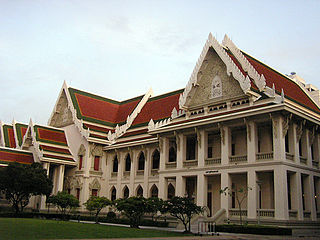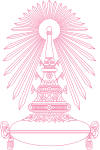
Thammasat University is a public research university in Thailand with campuses in Tha Phra Chan area of Phra Nakhon District near the Grand Palace in the heart of Bangkok; in Rangsit, 42 kilometers north of Bangkok; in Pattaya, a resort city on the eastern seaboard of Thailand; and in Lampang Province.

Chulalongkorn University, nicknamed Chula, is a public and autonomous research university in Bangkok, Thailand. The university was originally founded during King Chulalongkorn's reign as a school for training royal pages and civil servants in 1899 at the Grand Palace of Thailand. It was later established as a national university in 1917, making it the oldest institute of higher education in Thailand.
Education in Thailand is provided mainly by the Thai government through the Ministry of Education from pre-school to senior high school. A free basic education of fifteen years is guaranteed by the constitution.

King Mongkut's Institute of Technology Ladkrabang is a research and educational institution in Thailand. It is situated in Lat Krabang District, Bangkok approximately 30 km east of the city center. The university consists of nine faculties: engineering, architecture, science, industrial education and technology, agricultural technology, information technology, food industry, liberal arts, and medicine.
Mahidol University (Mahidol), an autonomous research institution in Thailand, had its origin in the establishment of Siriraj Hospital in 1888. Mahidol had an acceptance rate for Medicine of 0.4% as of the 2016 academic year. Becoming the University of Medical Science in 1943, it has been recognized as the country's fourth public university. The university was later renamed in 1969 by King Bhumibol Adulyadej after his father, Prince Mahidol of Songkhla, the "Father of Modern Medicine and Public Health of Thailand". The university originally focused on health sciences but expanded to other fields in recent decades. It hosted Thailand's first medical school, the Siriraj Medical School. Today, Mahidol offers a range of graduate and undergraduate programs from natural sciences to liberal arts with remote campuses in Kanchanaburi, Nakhon Sawan, and Amnat Charoen provinces. There are a total of 629 programs offered from 17 faculties, 6 colleges, 9 research institutions and 6 campuses. In terms of fiscal budget and portion of budget spent on research programs, the university receives the highest budget of any public university in Thailand: $430 million in 2019, most of which is granted for graduate research programs. Mahidol University was ranked Thailand's #1 university in 2011 by QS Asian University Rankings.

Faculty of Medicine Siriraj Hospital, Mahidol University is the oldest and largest medical school and oldest of any kind of university faculty in Thailand. The faculty is now part of Mahidol University. Founded in 1889, the faculty was run in co-operation with Siriraj Hospital, the first public hospital in Thailand, which provided the students the clinical experiences. The faculty's campus and hospital is in the Bangkok Noi District, Bangkok, on the former Rear Palace. The medical school accepts about 250 students for the undergraduate education and more than 100 to postgraduate studies each year.

A public policy school is typically a university program that teaches students policy analysis, policy studies, public policy, political economy, urban planning, public administration, public affairs and/or public management. Public policy schools typically train students in two streams. The more practical stream treats the master's degree as a terminal degree, which trains students to work as policy analysts or practitioners in governments, think tanks and consulting firms. A more theoretical stream aims to train students who are aiming to go on to complete doctoral studies, with the goal of becoming professors of public policy or researchers.
The American University School of Public Affairs (SPA) is an institution of higher education and research located in Washington, D.C. that grants academic degrees in political science, public administration, public policy, and justice, law and criminology. Established in 1934 as part of American University, the school houses three academic departments - Public Administration & Policy, Government, and Justice, Law & Criminology - as well as ten centers and institutes.
Northwest University of Political Science and Law is a university in Xi'an, and one of the top law schools in China. The university serves as the educational center of law in the northwest part of China and as one of the key bases of law institutions of higher learning in China.

The Faculty of Medicine, Chulalongkorn University, the second oldest medical school in Thailand, was established in 1947 in accordance with the wishes of King Ananda Mahidol to educate a sufficient number of medical doctors to satisfy the public's demands. For more than half a century, this medical school has provided society with more than 5,000 medical doctors. The school accepts about 300 medical students and more than 100 for postgraduate residency training each year. It has been ranked as one of the best medical schools in Thailand in 2016.

The Faculty of Arts, Chulalongkorn University, was established in 1917. It was one of the first four faculties of the university. Its former name was "Faculty of Arts and Science". At the time of its establishment, the first two missions of the faculty were to teach the students humanities and sciences and to produce secondary school teachers. In 1934, the faculty started to offer a bachelor's degree of arts. Today, there are undergraduate and graduate programs.

The Faculty of Law, Thammasat University is an administrative agency of the Thai government, being an academic faculty attached to Thammasat University, Ministry of Education. It is the second oldest university faculty in the country, preceded only by the Faculty of Medicine, Mahidol University. It has long played a major role in the politics of Thailand and among its graduates are many former prime ministers, ministers, senior government officers, judges, and other public figures.
The Shanghai University of Political Science and Law (SHUPL) is a public university in Shanghai, China,
Rajamangala University of Technology Lanna is a science and technology university in Chiang Mai Province, northern Thailand. It offers vocational certificate, advanced vocational certificate, undergraduate, and master's degrees.

Faculty of Pharmaceutical Sciences, Chulalongkorn University is the first Pharmacy school in Thailand, located in Bangkok. The faculty was founded by Prince Rangsit Prayurasakdi on December 8, 1913 as a department of Doctor for Compounding in the Royal Medical College, commonly called "Rong Rean Prung Ya" which means "School of Compounding Medicine". After the establishment of Chulalongkorn University in 1916, the Royal Medical College became the Faculty of Medicine under the university. The department of Compounding Medicine also had been renamed to "Panak Phat Pasom Ya" or "Doctor for Compounding Medicine Department" since April 6, 1917. It is the first time that Pharmacy Education in Thailand has been elevated in higher educational system.

Windsor Palace was situated in Bangkok, Thailand, during the early twentieth century. Built on the orders of King Chulalongkorn to serve as the residence of Crown Prince Vajirunhis, the palace later became part of Chulalongkorn University but was later demolished to make way for the construction of Suphachalasai Stadium. The palace became known as such to foreign residents of Bangkok due to its partial resemblance to Windsor Castle, though it was also known to locals as Wang Klang Thung or Wang Mai.

The Academic dress of Chulalongkorn University is a long-sleeved gown made from light mesh, faced and bordered with a specially designed felt strip. The same strip is also attached to elbows and wrists. The gown itself is adapted from ceremonial attire called suea khrui and was designed in Prajadhipok's reign, together with the existing academic badge.

Phramongkutklao College of Medicine is the first and only medical cadet school in Thailand. The college is the seventh medical school established in Thailand by a royal command of King Bhumibol Adulyadej. Phramongkutklao College of Medicine is an affiliated college of Mahidol University.
Chulalongkorn University in Thailand comprises nineteen constituent faculties, as well as six schools and colleges, which form the university's teaching units. Together, they offer 76 undergraduate and 375 postgraduate programmes, and host the university's 25,940 undergraduate and 11,424 postgraduate students. Each of the faculties is focused on a specific subject area. All undergraduate and most postgraduate students will apply for a programme of study under a specific faculty, and will belong with that faculty throughout the duration of their studies.

The campus of Chulalongkorn University in Bangkok occupies an area of 637 rai in the city centre's Pathum Wan District. It accounts for just over half of the 1,153 rai of land owned by the university, the rest of which is commercially developed or used by other institutions. The campus sits on what was originally royal land surrounding Windsor Palace, granted for the university's use at its foundation in 1917 by King Vajiravudh. Ownership of the land was transferred to the university by an Act of Parliament in 1939.














